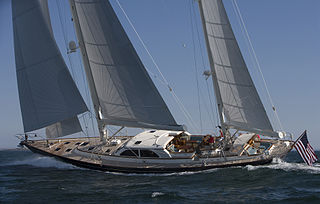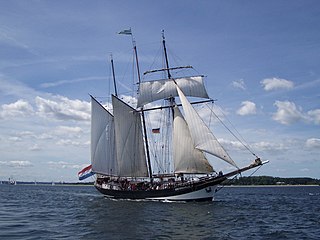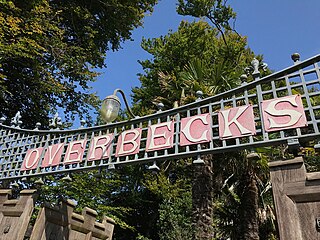
A yacht is a sail or power vessel used for pleasure, cruising, or racing. There is no standard definition, so the term applies to such vessels that have a cabin with amenities that accommodate overnight use. To be termed a yacht, as opposed to a boat, such a pleasure vessel is likely to be at least 33 feet (10 m) in length and may have been judged to have good aesthetic qualities.

A sloop is a sailboat with a single mast typically meaning one headsail in front of the mast, and one mainsail aft of (behind) the mast. This is called a fore-and-aft rig, and can be rigged as a Bermuda rig with triangular sails fore and aft, or as a gaff-rig with triangular foresails and a gaff rigged mainsail. Sailboats can be classified according to type of rig, and so a sailboat may be a sloop, catboat, cutter, ketch, yawl, or schooner. A sloop usually has only one headsail, although an exception is the Friendship sloop, which is usually gaff-rigged with a bowsprit and multiple headsails. If the vessel has two or more headsails, the term cutter may be used, especially if the mast is stepped further towards the back of the boat.

A schooner is a type of sailing vessel defined by its rig: fore-and-aft rigged on all of 2 or more masts and, in the case of a 2 masted schooner, the foremast generally being shorter than the mainmast. A common variant, the topsail schooner also has a square topsail on the foremast, to which may be added a topgallant and other square sails, but not a fore course, as that would make the vessel a brigantine. Many schooners are gaff-rigged, but other examples include Bermuda rig and the staysail schooner.

A sailboat or sailing boat is a boat propelled partly or entirely by sails and is smaller than a sailing ship. Distinctions in what constitutes a sailing boat and ship vary by region and maritime culture.

A Yawl is a type of boat. The term has several meanings. It can apply to the rig, to the hull type or to the use which the vessel is put.

A scow is a type of flat-bottomed barge. Some scows are rigged as sailing scows. In the 19th and early 20th centuries, scows carried cargo in coastal waters and inland waterways, having an advantage for navigating shallow water or small harbours. Scows were in common use in the American Great Lakes and other parts of the U.S., in southern England, and in New Zealand. In Canada, scows have traditionally been used to transport cattle to the islands of New Brunswick's Saint John River. In modern times their main purpose is for recreation and racing.

A tall ship is a large, traditionally-rigged sailing vessel. Popular modern tall ship rigs include topsail schooners, brigantines, brigs and barques. "Tall ship" can also be defined more specifically by an organization, such as for a race or festival.

Salcombe is a popular resort town in the South Hams district of Devon, south west England. The town is close to the mouth of the Kingsbridge Estuary, mostly built on the steep west side of the estuary. It lies within the South Devon Area of Outstanding Natural Beauty (AONB). The town's extensive waterfront and the naturally sheltered harbour formed by the estuary gave rise to its success as a boat and shipbuilding and sailing port and, in modern times, tourism especially in the form of pleasure sailing and yachting. The town is also home to a traditional shellfish fishing industry. The town is part of the electoral ward of Salcombe and Malborough, for which the 2011 census recorded a total population of 3,353.

A cutter is generally a small- to medium-sized vessel, depending on its role and definition. Historically, it was a smallish single-masted, decked sailcraft designed for speed rather than capacity. As such, it was gaff-rigged, with two or more headsails and often a bowsprit of some length, with a mast sometimes set farther back than on a sloop. While historically a workboat, as used by harbor pilots, the military, and privateers, sailing cutters today are most commonly fore-and-aft rigged private yachts.

The Cornish pilot gig is a six-oared rowing boat, clinker-built of Cornish narrow-leaf elm, 32 feet (9.8 m) long with a beam of 4 feet 10 inches (1.47 m). It is recognised as one of the first shore-based lifeboats that went to vessels in distress, with recorded rescues going back as far as the late 17th century. The original purpose of the Cornish pilot gig was as a general work boat, and the craft is used as a pilot boat, taking pilots out to incoming vessels off the Atlantic Coast. At the time pilots would compete between each other for work; the fastest gig crew who got their pilot on board a vessel first would get the job, and hence the payment.

A pilot boat is a type of boat used to transport maritime pilots between land and the inbound or outbound ships that they are piloting.

Philip C. Bolger was a prolific American boat designer, who was born and lived in Gloucester, Massachusetts. He began work full-time as a draftsman for boat designers Lindsay Lord and then John Hacker in the early 1950s.
The sport and practice of single-handed sailing or solo sailing is sailing with only one crewmember. The term usually refers to ocean and long-distance sailing and is used in competitive sailing and among Cruisers.

Overbeck's Museum and Garden is an Edwardian house and 2.75 hectare garden at Sharpitor, Salcombe, Devon, England. It is named after its last private owner Otto Christop Joseph Gerhardt Ludwig Overbeck (1860–1937).

A fishing vessel is a boat or ship used to catch fish in the sea, or on a lake or river. Many different kinds of vessels are used in commercial, artisanal and recreational fishing.

Myron Spaulding was an American sailor, yacht designer and builder and concert violinist in Sausalito, California.
The Falmouth Quay Punt was a type of working sailing vessel in the port of Falmouth, Cornwall in the 19th and early 20th century. They would be hired by merchant ships anchored in Carrick Roads – to carry stores, mail and passengers. Falmouth, with a good deep water harbour situated near the Western entrance to the English Channel, was a popular port for merchant sailing ships to call "for orders". Before the days of radio, captains would often not know which port their cargo would be destined for before they arrived in the country, and needed to collect instructions before continuing.

Salcombe Lifeboat Station is the base for Royal National Lifeboat Institution (RNLI) search and rescue operations at Salcombe, Devon in England. The first lifeboat was stationed in the town in 1869. The Salcombe Lifeboat has twice capsized, in 1916 with the loss of 13 lives, and in 1983 with no loss of life. Since 2008 the station has operated a Tamar-class all weather boat (ALB) and an Atlantic 75 inshore lifeboat (ILB).

A Bristol Channel pilot cutter is a specialised sailing boat the style and design of which is derived from the single-masted cutter. Based upon bulkier, less nimble fishing boats but modified for use in the strong tides, winds, currents and coastline of the Bristol Channel its purpose was to quickly ferry local maritime pilots to and from large ships to assist in safe navigation into or out of port cities in the Channel. The speed and manoeuvrability of the cutters allowed a minimal crew in almost any weather. They could quickly arrive at and easily lie alongside larger ships for safe transfer of pilots. The craft was equipped to remain on station for days or even weeks, awaiting arrivals outside the channel.
Salcombe is a resort town in the South Hams district of Devon, south west England.

















